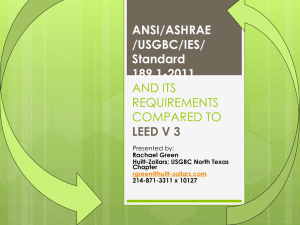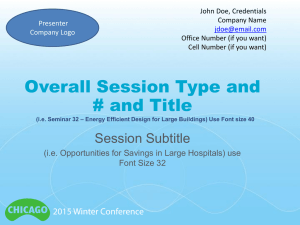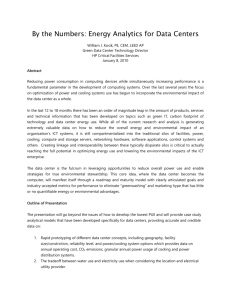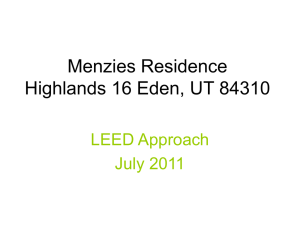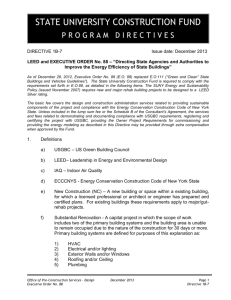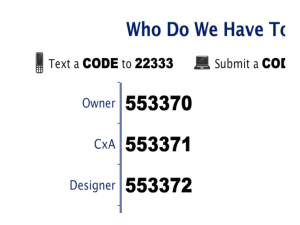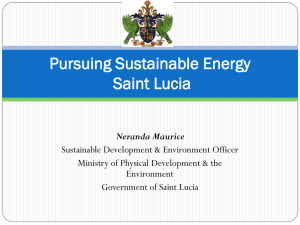Click Here to Presentation
advertisement
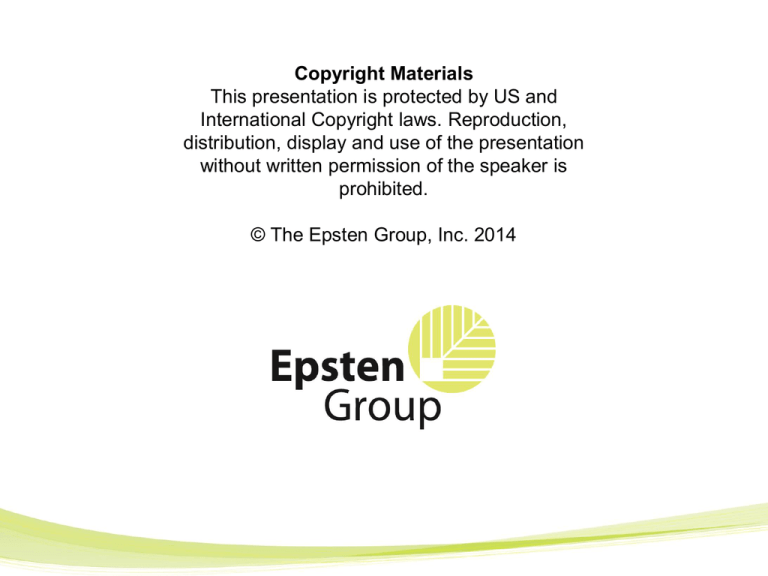
Copyright Materials This presentation is protected by US and International Copyright laws. Reproduction, distribution, display and use of the presentation without written permission of the speaker is prohibited. © The Epsten Group, Inc. 2014 About Us • Established in 1991 • Multi-Disciplinary • 6,000 LEED Reviews in 50+ Countries • Small Disadvantaged Business; 8(m) WOSB Epsten Group Services: Commissioning Retro-Commissioning Building Envelope Services Roofing & Waterproofing Consulting Architecture & Interior Design LEED Consulting Energy Modeling Guide to ASHRAE 90.1 Changes Presentation for CxEnergy 2014 AABC Commissioning Group L a s Ve g a s , N e v a d a April 23, 2014 Learning Objectives At the end of this course, participants will be able to: 1. 2. 3. 4. Participants will learn how the ASHRAE 90.1 energy standard has evolved in recent years up to the current version that has been adopted. Participants will be able to distinguish the major amendments to the standard that have led to substantial energy improvements from the last version. Participants will learn how the changes to 90.1 and its Appendix G will affect the latest version of LEED and consequentially building energy models. Participants will learn how the changes to the standard will impact the building industry and particularly how it will impact commissioning providers. 1.0 Evolution First drafted in 1975 Major re-write of the standard in 1999 Continuous maintenance began in 2001 (every 3 years) ASHRAE 90.1-2007 updated from 2004 via 44 addenda ASHRAE 90.1-2010 updated from 2007 with more than 100 addenda 1.1 ASHRAE 90.1-2010 Goal Set out to achieve a 30% energy savings when compared to ASHRAE 90.1-2004. Goal achievement proven by Pacific Northwest National Laboratory (PNNL) Substantial energy efficiency improvement when compared to earlier iterations Sidenote: Significant implications for LEED pursuit in LEED v4 1.2 Major Sections 5.X Envelope 6.X Mechanical 7.X Service Water Heating 8.X Power 9.X Lighting Appendix G (Performance Rating Method) 1.3 Compliance 5.X Envelope 6.X Mechanical 7.X Service Water Heating 8.X Power 9.X Lighting Appendix G (Performance Rating Method) 1.4 Climate Zones 1.5 Building Prototypes Small/Medium/Large Offices Retail/Strip Mall Primary/Secondary Schools Outpatient Healthcare Hospital Small/Large Hotels Warehouse Quick/Full-Service Restaurants Mid-Rise/High-Rise Apartments 2.0 Envelope Changes Continuous air barrier Cool roofs Constraints on glazing 2.0.1 Air Barriers A properly functioning air barrier system provides a barrier against both the air leakage and the diffusion of air caused by wind, stack, and mechanical equipment pressures. – – According to the ABAA, air leakage can result in increased energy costs of up to 30-40% in heating climates and 10-15% in cooling climates The additional benefit to air barriers is that they keep unconditioned, moist air out of the building and reduce the possibility of mold growth 2.1.1Continuous Air Barrier Permeance ≤ 0.004 cfm/sf – Permeance ≤ 0.04 cfm/sf – Individual materials: plywood, insulation board, metal Assemblies or materials All air barrier components must be clear on documents All joints, penetrations must be detailed Barrier must extend over all envelope surfaces Barrier must be design to resist positive AND negative pressures 2.1.2 Continuous Air Barrier Construction of barrier must include sealing, caulking, gasketing, or weather-stripping: – – – – Joints (windows and doors) Junctions of walls to foundation or roofs Openings Any penetrations through vapor retarders Exceptions: – Semi-heated spaces in Climate Zone 1 through Zone 6 2.2 Cool Roofs Required in Climate Zone 1 through Zone 3 Certified by ASTM – – – 3 year aged solar reflectance ≥ 0.55 and emmittance ≥ 0.75 OR 3 year aged SRI ≥ 64 OR Increased insulation of Table 5.5.3.1.2 Numerous exceptions are noted 2.3 Glazing Window Wall Ratio ≤ 40% of gross wall area (prescriptive path) Skylight roof ratio ≤ 5% of roof area Major changes for SHGCs over 90.1-2004 which apply to all orientations SHGC reductions through use of overhangs 3.0 HVAC Changes Efficiency ratings on equipment Energy recovery Economizers Duct sealing/leakage Fan power Reheat 3.1 Simplified Approach Option Only applies to HVAC section Acceptable for buildings that are 1 to 2 stories and < 25,000 sf Must also meet 17 separate criteria 3.2 Efficiency Updates Unitary AC and heat pumps Single zone VAV Water-cooled units Packaged units and heat pumps Water-to-water heat pumps CRAC units VRF Chillers Cooling towers Heat exchangers Heat pump pool heaters Furnaces and water heating 3.3 Economizers Comfort cooling – – Computer rooms – – Not required for 1A and 1B Required for all other zones where the cooling capacity is ≥ 54,000 Btu/h Not required in 1A, 1B, 2A, 3A, 4A Required in other zones dependent on tonnage Exempt: – If able to prove efficiency improvement for the climate zone 3.4 Waterside Two-position valves in water-cooled units (i.e. SWUD units) Variable flow/pumping Pump pressure optimization No regulation downstream of booster pumps Maximum flows in nominal pipe sizes Significant insulation upgrades, particularly for steam and hot water systems 3.5.1 Airside Ventilation optimization Supply air temp reset Limitation on damper leakage Dual maximum for VAV terminal units Overhead heating temp limit Lab VAV exhaust air Demand control ventilation Fan power limitation 3.5.2 Airside Exhaust air energy recovery 4.0 Lighting Changes Lighting power density improvements Exterior building lighting updates Grounds lighting 4.1 Lighting Power Density Most spaces defined in standard have lower LPDs than 2007 and reductions are substantial Important to keep in mind impact of these requirements on cooling and heating load calculations Average reduction of 16.2% in LPDs versus 90.1-2007 4.2 Auto Shutoff/Dimming Time clock with separate shutoff for each floor or building > 25,000 sf OR Occupancy sensors set to 30 minutes Separate signal from controls indicated the space is unoccupied Daylight switching for daylit areas > 250 sf OR 4.3 Exterior Lighting Turn off when adequate daylight available Façade and landscape lighting off between closing or midnight and 6 am or opening Reduced lighting of advertising overnight Reduction in lighting power densities, depending on zone 5.0 LEED EAp2 Impact LEED v2009 requires a 10% energy cost savings when compared to the baseline building as defined by ASHRAE 90.1-2007 LEED v4 requires a 5% energy cost savings when compared to the baseline building as defined by ASHRAE 90.1-2010 5.1 LEED EAc1 Impact EAc1 Point Comparison 60% 54% 50% 50% 46% 44% 42% 46% 40% 38% 40% 42% 36% 34% 35% 30% 28% v4 32% 26% 29% 24% 22% 26% 20% 24% 18% 20% v2009 38% 32% 30% 50% 48% 22% 16% 20% 14% 18% 16% 14% 10% 12% 10% 8% 6% 0% 0 2 4 6 8 10 12 14 16 18 20 6.0.1 Energy Modeling Impact Appendix G – – – – Section G1.4 has been revised to include a more detailed list of required documentation to be submitted to the rating authority. Section G2.5 has been revised to more clearly explain the Exceptional Calculation Method procedure and what documentation is required to justify the results. Section G3.1.1 includes new exceptions for additional system types for kitchens and heated only spaces (new Baseline system types 9 and 10). Section G3.1.1.1 through Section G3.1.1.3 provide new guidance for modeling district heating and cooling systems. 6.0.2 Energy Modeling Impact Appendix G (continued) – – – – Table G3.1(14) includes new guidance regarding “exterior conditions” (adjacent structures and terrain, ground temperatures, and water main temperatures). Section G3.1.2.6 has been revised to more clearly explain how to take credit for improved ventilation systems (i.e. demand control ventilation) Section G3.1.2.9 includes new provision for sizing supply air volumes in the Baseline model for laboratories. Section G3.1.3.13 includes additional requirements for VAV minimum setpoints in the Baseline model for laboratories. 7.0 Impact on Building Industry Jump in energy performance requirements to drive vendors to be more aggressive Architects, engineers and contractors will have a learning curve on new requirements Initially expect increased cost of construction while industry catches up Even more importance now on technical competence across all trades, but specific focus on controls technicians that are required to implement more complex strategies 7.1 Impact on Commissioning Elevated performance requirements leading to more complex building systems – – – HVAC and Controls Lighting controls Integration of other systems Commissioning providers required to be knowledgeable on optimization requirements stipulated in energy code Opportunity for commissioning professionals to provide guidance and lessons learned on success of optimization strategies to design engineers 7.2 References http://www.seco.cpa.state.tx.us/tbec/videos.php http://www.pnnl.gov/publications/abstracts.asp?report=3 58270 Conclusion Knowledge acquired: 1. 2. 3. 4. Participants learned how the ASHRAE 90.1 energy standard has evolved in recent years up to the current version that has been adopted. Participants are able to distinguish the major amendments to the standard that have led to substantial energy improvements from the last version. Participants learned how the changes to 90.1 and its Appendix G will affect the latest version of LEED and consequentially building energy models. Participants learned how the changes to the standard will impact the building industry and particularly how it will impact commissioning providers. Questions Please feel free to ask any questions you may have for today’s course presenters. Thank You For Your Time About Us • Established in 1991 • Multi-Disciplinary • 5,500 LEED Reviews in 50+ Countries • 8(a) Certified; Small Disadvantaged Business; 8(m) WOSB Epsten Group Services: Commissioning Retro-Commissioning Building Envelope Services Roofing & Waterproofing Consulting Architecture & Interior Design LEED Consulting Energy Modeling
